Over the last few weeks I have been trying out the Suunto Ambit 2S. As with our other report on the Suunto Ambit 2GPS this is very much a personal review from an average user rather than an in depth technical review, which if you are interested can be found here. Given that it is a personal review it is useful to know the points of comparison, for years I was a Polar fan, the last model being the RS800CX, but a year ago I switched to the Garmin Forerunner 910XT for the internal GPS, multisport and swim training features. The Garmin has been my constant companion ever since. For the purposes of reviewing the Suunto I wore both the Garmin and the Suunto for swim, bike and run training sessions.
What struck me straight off was that the Suunto is more of a watch, whereas the Garmin is essentially a training computer on your wrist. The Suunto looks good, and I am happy to wear it around all day. The Garmin is only worn when training and to be honest I find it a pretty ordinary ‘time piece’. What also impressed over the period of the trial was the battery life of the Suunto. With the unit in constant use I only needed to recharge it after 8 days, and the unit recharges anyway when it is plugged into the computer to download your training sessions. With the Garmin I switch it off between all training sessions, and still need to recharge it every 2-3 days. I suppose it is all relative, the Polar used to have its battery replaced after about 18 months.
The second thing I was struck by is that the Suunto requires a bit more effort to get set up than the Garmin, which is ready to use out of the box. I found the watch buttons and menu screens to be rather less intuitive than the Garmin and spent about 30 minutes or so preparing the watch to be ready for my first session. This also only gave me basic functionality, to set the watch up to record 1K intervals on the run, and to change the screen so that I could see the data I was interested in required me to download the www.movescount.com software onto my computer and make the changes there for upload to the watch. Even then it was that not easy, and I was annoyed to return from a 21K run to find that contrary to expectations I only had a single run split and could not track my pace over the course. More reading up and set up required on my part. Am I the only one that gets annoyed by the lack of anything other than a very basic user guide being included with purchases now?
In terms of fit and feel, the Suunto feels a little heavier than the Garmin on my wrist, and being circular did not fit quite as comfortably into the wrist as the rectangular Garmin, but this was only minor, and the Suunto was comfortable. The loops used to keep the strap in place are very effective, so effective in fact that releasing the strap requires a bit of effort!
The Suunto scores very highly in my books on the display. The display is really big and easy to read when training in all sports, and the backlight (with a really nice feature of being able to reverse the display lighting) makes reading the display in poor lighting super easy. Much better than either the Garmin or Polar in this regard.
Unlike the Polar and Garmin there is no wireless transfer of data to your computer. My initial reaction was that having to plug your unit in to the computer was a bit of a pain, however I have changed my mind. Often with the wireless transfers I encounter problems with data not transferring correctly or at all. No such problems when you directly connect the unit, with the added advantage that your units’ battery is also being recharged. I now think this is a plus.
In terms of the analysis you are able to do on your training, the Movescount software does not appear on first glance to be as flexible and detailed as the Garmin software. Having said that as you can see from the screengrab (below) it provides all the basic information you need, including (on the run) maps, speed/pace and altitude, and splits when you work out how to set them! Suunto has also provided the ability for users to create Apps, which allows you to access a great range of features that will continue to grow. There are hundreds of pages of Apps, you can track your heart rate zones, the incline of the hill you are ascending, and my personal favourite one that tells you how many beers you have burnt (and therefore how many I can have after the session!)
My big bug bear with the Garmin is the altitude recording. While originally this feature worked well, after one of the not infrequent firmware upgrades this feature stopped working, and going by the blogs this is a common fault. I am often amused to see now that I can gain 19,000 meters in a swim squad. No such problems with the Suunto.
So in summary I think if you want one unit that combines as a cool time piece and a serious training tool the Suunto ticks the boxes very nicely. It does require a little initial set up, but in reality this is minimal and a poor reflection on us if we have become so lazy and in need of instant gratificaton that we cannot expend a little bit of effort up front.








